#porticus
Explore tagged Tumblr posts
Text
Normans building churches in Britain: We shall construct giant towers, intricate facades, imposing yet beautiful columns.
Anglo-Saxons building churches in Britain: make that boi long and tall
#history#x#Great Britain#Normans: We are breathing the spirit of Rome into this pagan place.#Anglo-Saxons: oh recycle those bricks from hadrian's wall. yeah stick em in the porticus
220 notes
·
View notes
Text
The latin word porticus is such a weird word to use in my very gendered native language
In english its just so simple, but without translating it I just cant find the correct article or pronoun!!
Is it masculin? Feminin? Neutral?? I have used every one of genders in my notes so far and none feel right!!
#latin language#academic victim#dead languages are hard#maybe the gender for porticus is the friends we made along the way
0 notes
Text
Archeologia / Roma, la Porticus Minucia riemerge in via delle Botteghe Oscure: ecco le immagini in 3D della ricostruzione [VIDEO]
Archeologia / Roma, la Porticus Minucia riemerge in via delle Botteghe Oscure: ecco le immagini in 3D della ricostruzione [VIDEO]
Redazione Un’importante scoperta archeologica, un esempio di valorizzazione, una collaborazione virtuosa tra pubblico e privato: è il ritrovamento di una parte della Porticus Minucia, avvenuto durante i lavori a Palazzo Lares Permarini in Via delle Botteghe Oscure 46, un ulteriore tassello alla conoscenza del grandioso quadriportico costruito in epoca repubblicana, che abbracciava l’area del…

View On WordPress
#antica roma#archeologia#Porticus Minucia#ricostruzioni 3D#scavi#scavi archeologici#Soprintendenza Speciale di Roma#video
0 notes
Text
non dissimulat, patres conscripti: apparet esse commotum; sudat, pallet. quidlibet, modo ne nauseet, faciat, quod in porticu Minucia fecit.
He does not hide it, senators: it is clear he is agitated; he sweats, he grows pale. Let him do what he likes, so long as he does not vomit, as he did at the Portico of Minucius.
Cic. Phil. 2.84
Happy Cicero "Mom's Spaghetti" Monday!
#latin#ancient rome#cicero#mark antony#tagamemnon#remaking this post because i keep thinking about cicero moms spaghetti
62 notes
·
View notes
Photo
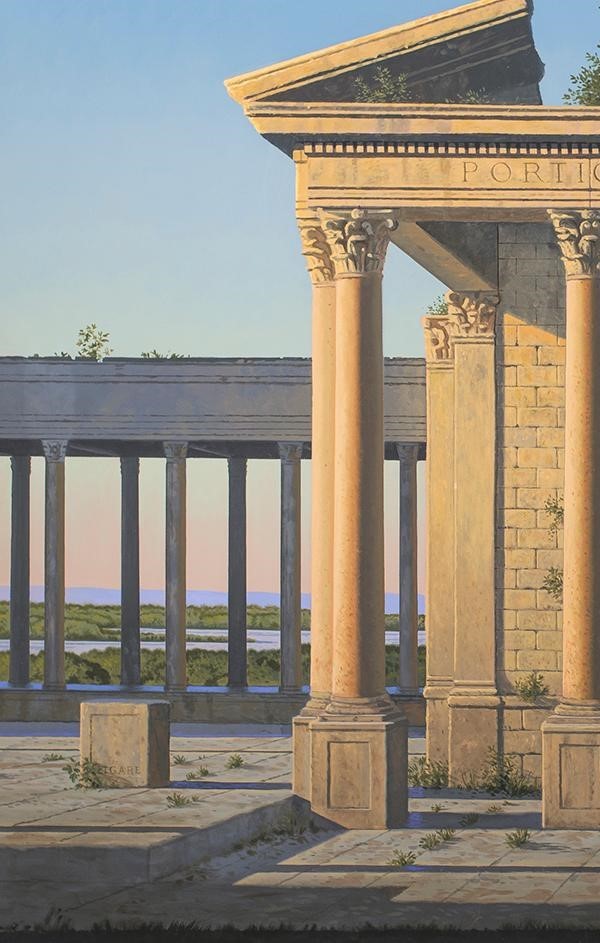
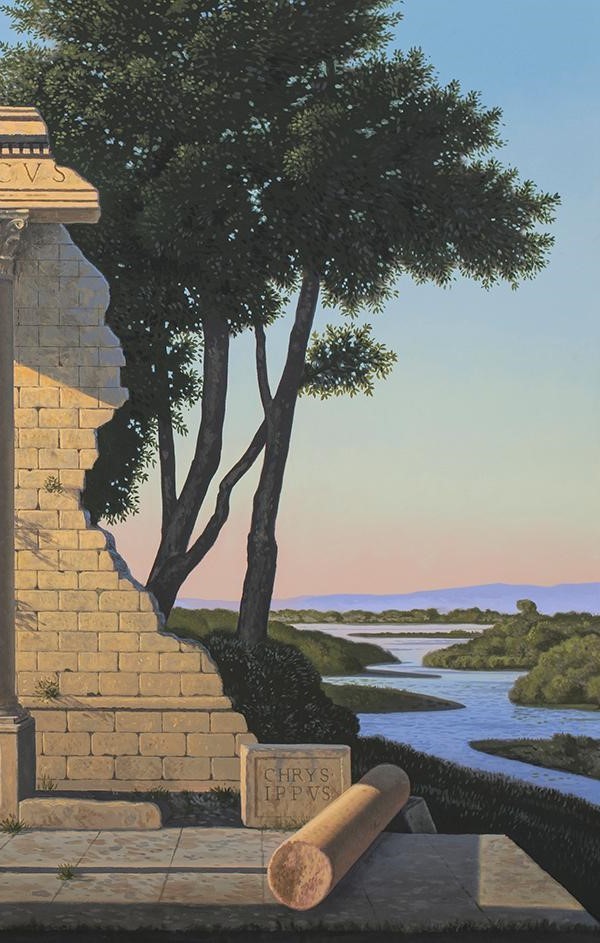
Porticus by David Ligare
#David Ligare#hyper realism#oil painting#oil on canvas#painting#contemporary art#contemporary landscape#landscape#art#21st century#21st century art#architecture#roman architecture#roman ruins#ruins#dark academia#light academia
735 notes
·
View notes
Text
wait i didn’t realise that the porticus catuli was built on the site of flaccus’ house!! that’s so funny because it was also next door to cicero’s house which clodius razed when he exiled cicero and built a shrine on the site of! (possibly he also accidentally burnt down the porticus catuli as well???) (tribunician alert: the attempts to overwrite the existence of your political enemies via public monuments are fightingggg) and cicero’s house was either the same house as or on the site of marcus livius drusus tr91’s house that was built with massive windows so everyone could see how cool and virtuous he was. interesting interaction between various directions of memorialisation going on there!
trial of Quintus Lutatius Catulus
date: late 87 BCE charge: iudicium populi [trial before the people], for perduellio [high treason]? defendant: Q. Lutatius Catulus cos. 102 prosecutor: M. Marius Gratidianus tr. pl. 87 or 86, pr. 85? and 82?
Cic. de Orat. 3.9; Brut. 307; Tusc. 5.56; N.D. 3.80; Diod. 39.4.2; Vell. 2.22.4; V. Max. 9.12.4; Plut. Mar. 44.5; App. BCiv. 1.74; Flor. Epit. 2.9.15; Schol. Bern. on Lucan 2.173; Schol. Bob. 176St; August. C.D. 3.27
#like i don’t remember the details but the porticus catuli being Vaguely Anti Gracchi makes it seem possible that clodius burning it down was#Not An Accident. was fulvia related to that fulvius or.#also how come catulus gets a porticus AND a tomb.#quintus lutatius catulus#publius clodius pulcher#beeps
66 notes
·
View notes
Text

I wrote about some of the stuff on Geppetto’s blackboard months ago, and now that I have since learned how to actually look at the game’s files and manipulate the camera better, I figured I would take another look, starting with the “Daffodils and Narcissus” paper. There’s one on Geppetto’s blackboard, as well as on his desk and in various other parts of the game (perhaps notably, Lorenzini Arcade).
Initially I wasn’t super interested in this because I figured it was just a “lorem ipsum” sort of thing, and I still think it is, but conversely: the text comes (paraphrased, and otherwise mixed and added to) from an actual book published in 1923 that you can take a gander at online: Archive.org | some related images on Flickr from the Biodiversity Heritage Library
The full Lies of P text is below, but some notes: 1. I wasn’t sure if “forcing” and “flanged” were the right terms, but it’s used in the original so I assume it’s correct. 2. “We/our” from the original text has been changed to “I/my” in the game version. Maybe one of the devs just really likes flowers or they thought it was funny. Either way, valid. 3. There are undoubtedly errors, and I’ve intentionally kept some misspellings.
⬇️
Miss Ella V. Baines, The Woman Florist, Springfield Ohio. 11
Daffodils and Narcissus.
Sweet harbingers of Spring, that jump from old Winter’s lap, with cheeks of gold and silver and bedecking the earth with beauty, filling the air with delicious perfume. The wonderful creations in the way of new varieties have awakened an interest and enthusiasm among the lovers of flowers that has placed this, “The Flower of the Poets,” in the front rank of popularity and they merit all the praise that can be bestowed upon them. Appearing as they do, just after bleak Winter, they turn our gardens, lawns, and woodlawn walks into gorgeous masses of gold and silver, with a fragrance that is enchanting.
Note. — I wish to say my friends that the different varieties of Narcissus force into bloom in the house during Winter as readily as the Hyacinths. There is nothing finer in the flower line for this purpose. Indeed, they are my choice of all Winter flowering bulbs. They are so graceful and pretty. I can especially recommend for house culture the following charming varieties: Golden Spur, Porticus Ornatus, Orange Phoenix, Sulphur Pheonix, Von Sion, Horsfieldii, Giant Princess, Paper White, Chinese Sacred Lily and Golden Sacred Lily. Try these variations. They will not disappoint you.
Henry Irving. — Long, beautifully frilled trumpet nearly two inches wide at the mouth of rich golden yellow color. Petals of perianth very wide over lapping bright yellow. Received first class certificate. 10 cents each; three for 25 cents.
Hale’s Beaten Gold, or Maximus. — Large flower, rich yellow, elegantly twisted perianth, trumpet deep golden, large, well flanged. 10 cents each; three for 25 cents.
Obvallaris. — Tenby Daffodil. Elegantly formed, medium sized flower of rich yellow. Splendid for forcing. 8 cents each; four for 25 cents.
Large Trumpet Narcissus.
Two Colored Varieties — White and Yellow.
Grandis. — Flowers of the largest size, with broad, snow white petals and a magnificent yellow tube. Very beautiful. A flower of great substance and grand for cutting. 10 cents each; six for 50c.
Horsfieldii. — (Empress) The Queen of the Daffodils. This variety is considered the best of all Narcissus. Try it. Very large flowers, pure white with rich yellow trumpet. Very stately and beautiful and one of the most elegant for ladies’ corsage wear. This magnificent flower was raised by a Lancashire weaver — John Horsfield — and it has made him famous. 10 cents each; six for 50 cents.
Scoticus. — The Scotch Garland Flower or Large-Flowering Lent Lily. Large flowers of creamy white, bright yellow trumpet, elegantly flanged and serrated. 6 cents each; 50 cents per dozen.
Giant Princess. — (Ajax Princeps) A magnificent flower. One of the finest specimens of the Trumpet type. Cream perianth with golden yellow trumpet. 5 cents each; 50 cents per dozen.
Moschatus. — White perianth. Trumpet opens creamy white and turns to pure white. It is very large and showy and it never fails to please everybody. 10 cents each; three for 25 cents.
All White Trumpet Narcissus.
Pallidus Praecox. — The White Pyrenees Daffodils. One of the earliest and most beautiful varieties. Both trumpt and Perianth are clear, sulphur white. Was awarded a first-class certificate by the London Royal Horticultural Society. One of the best for forcing. 6 cents each; 60 cents per dozen.
Albicans. — The White Spanish Daffodil. Creamy white, with a silvery white trumpet, slightly flushed with primrose and elegantly recurved at the brim. 10 cents each; three for 25 cents.
The True Poet’s Daffodils.
Narcissus, with Miniature Saucer-shaped Cups.
Poeticus Ornatus. — Large, beautifully formed, pure white flowers with saffron cup, tinged with rosy scarlet. A magnificent cut flower. Very early. This is my special favorite of all Narcissus. Try it. 5 cents each; 50 cents per doz.
Poeticus. — The “Pheasant’s Eye or Poet’s Narcissus.’ Pure white flowers, with orange cup, edged with crimson. Splendid cut flower. 3 cents each; 25 cents per dozen.
Poeticus Poetarum. — The flowers of this splendid variety are much larger and the orange rim more distinct in the cup. This beautiful variety will be welcomed as a decided improvement over the old Poeticus. 5 cents each; six for 25 cents.
Chalice Flowered or Semi-Trumpet Narcissus
Including the Incomparabilis Barril and Leedsil Types.
The trumpet in these varieties are only half the length or less of the other varieties of trumpets, hence called chalice flowered. They are very beautiful and desirable.
Barril Conspicus. — (Barrii) Perianth yellow. Short orange scarlet cup. Extra fine. 5 cents each; six for 25 cts.
Frigaro. (Incomparabilis) Perianth bright yellow, large orange scarlet cup. A very beautiful variety. 5 cents each; six for 25 cents.
Amabilis. — (Leedsii) Perianth pure white, cup or half trumpet primrose yellow fading to pure white. Very desirable. 5 cents each; six for 25 cents.
Duchess de Brabant. — (Leedsii) Periant white, cup or half trumpet a beautiful shade of canary yellow. Very fine. 5 cents each; six for 25 cents.
Albus Stella. (Incomparabilis) Large white perianth with yellow cup. This is an old and fashionable standby. 4 cents each; 40 cents per doxen.
Sir Watkin. — (The Giant Incomparabilis) Perianth rich sulphur, cup yellow, tinged orange. The best of all. Very beautiful. Extra. 10 cents each; three for 25 cents.
(Left column)
Giant-Flowered Narcissus or Daffodils.
Note. — In describing Narcissus I have referred to the “perianth” and “trumpet;” the latter is the long center, funnel-like tube, and the “perianth” is the surrounding row of petals, or leaves. All Narcissus on this page are hardy for garden planting. Also excellent for Winter flowering indoors.
Large Trumpet Narcissus — All Yellow.
Ard-Righ, or Irish King. — (Trumpet Major) — Earliest and most vigorous “Giant Trumpet Daffodil” in cultivation. Fine, bold flowers of immense size. Perianth and trumpet full, rich yellow. Extra fine sort for port culture and forcing. 5 cents each; six for 25 cents.
Emperor. — The Giant Narcissus. Largest of all. Flowers of richest yellow, trumpet immense, petals of perianth so large they overlap, and measure three and a half inches across. Petals a shade lighter than the trumpet. 10 cents each; six for 50 cents.
Golden Spur. — Extra large, bold, rich, yellow flowers. Foliage very broad and striking, unusually robust habit. Unsurpassed for gardens, pots, or forcing. 10 cents each; $1.00 per dozen.
#俺の#lies of p#unhinged details that nobody but me cares about CORRECT!!!!!!!!!!#i've read this over 800 times and now it's time for breakfast#extended post on dw etc you know how this goes#posted on dreamwidth#thank u lies of pp i have learned what perianth means
11 notes
·
View notes
Text
On the Augustan Temple of Apollo on the Palatine
Propertius II.31 You ask why I’ve come to you late? The golden portico Of Phoebus had been opened by great Caesar. So great a sight it was divided into by Punic columns – Among them, the daughter-crowd of old Danaus. Here marble Phoebus seemed to gape in song to the silent lyre (More handsome, it seemed to me, than the god himself); Around the altar stood a herd of Myron’s: four Crafted cows, statues that looked alive. Then the temple (shining marble) rose in the middle, Even dearer to Phoebus than Ortygia his homeland: On which, atop the roof-pole, was the chariot of the Sun, And doors, a noble work of Libyan ivory – The one mourned Gauls cast down from Parnassus’ peak, The other, the deaths of Tantalus’s daughter. Last, the Pythian god, between his mother and sister, In a long garment, rings out with song.
Quaeris, cur veniam tibi tardior? aurea Phoebi porticus a magno Caesare aperta fuit. tantam erat in speciem Poenis digesta columnis, inter quas Danai femina turba senis. hic equidem Phoebus visus mihi pulchrior ipso marmoreus tacita carmen hiare lyra; atque aram circum steterant armenta Myronis, quattuor artifices, vivida signa, boves. tum medium claro surgebat marmore templum, et patria Phoebo carius Ortygia: in quo Solis erat supra fastigia currus; et valvae, Libyci nobile dentis opus, altera deiectos Parnasi vertice Gallos, altera maerebat funera Tantalidos. deinde inter matrem deus ipse interque sororem Pythius in longa carmina veste sonat.
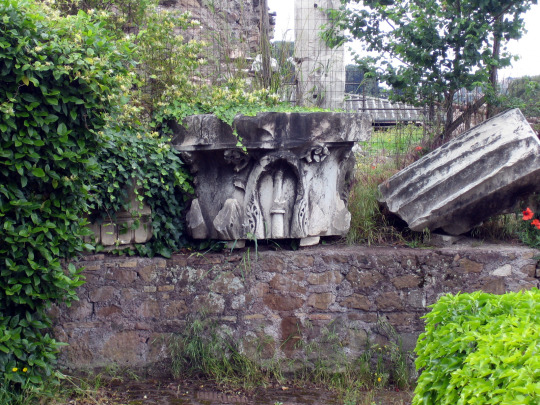
The remains of Apollo's temple on the Palatine Hill, Rome. Photo credit: Antmoose/Wikimedia Commons.
#classics#tagamemnon#Latin#latin language#lingua latina#langblr#translation#Latin translation#poem#poetry#poetry in translation#Ancient Rome#Roman Empire#Propertius#Roman religion#Ancient Roman religion#religio Romana#Apollo#Apollo Palatinus#elegiac couplets
70 notes
·
View notes
Text










Sint-Servaasbasiliek in Maastricht
(Pictures 1-5) The Mountain Portal (dutch: Bergportaal), Latin: Porticus montis, also called Mountain Gate or South Portal, is an early Gothic statue portal in the Basilica of St. Servatius in the Dutch city of Maastricht. In fact, the portal consists of a vestibule with three richly decorated walls at the southwestern Mountain Gate. The Mountain Portal is seen as an important link in the development of the Gothic church portal. The sculpture dates from the late 12th and early 13th centuries, making it the earliest example of Gothic sculpture in the Netherlands (Low Countries).
The first phase of construction was probably around 1170-80, after which construction probably stopped for some time, continuing shortly after 1200 and completing around 1215. In the meantime, plans had changed and it was decided to enlarge the portal using the already existing parts, which led to a somewhat forced result. There was also probably a change in the iconographic scheme: the older representations seem to point to a Marian portal; the later on a Christ or king's portal. The original portal consisted of the Marian representations on the lintel and tympanum, and the two inner archivolts. The lower parts of the side walls also appear to belong to this construction phase. The later extension consisted of the two outer archivolts, combined with an increase in the gate passage. In order to achieve a unity of style, the portal was painted with a blue-gray paint, traces of which were found on all parts.
(Pictures 6-8) exterior of the westwork of the church. The core of the monumental westwork of the St. Servatius Church was probably constructed during the first construction phase of the Romanesque church, but underwent a major renovation in the twelfth century. The heavy coal sandstone substructure has a rectangular plan with a slightly protruding middle section. The three horizontal facade zones decrease in height towards the top and are equipped with saving fields with round arches. In the upper zone there are round-arched windows with partial columns. In the course of the thirteenth century, the chimney walls or supporting arches were probably added, which extend over the street of Sint Servaasklooster. The northern and southern west towers (with nineteenth-century slate roofs) date from the same period. There have been several middle towers between these two towers over the centuries.
(Pictures 9-10) The so-called double relief on the westwork altar (ca. 1150-60) indicates by its shape that it was intended for the westwork from the beginning: the shape of the altar corresponds to the ground floor of the westwork; the two parts of the relief reflect the architectural structure of the imperial lodge in the westwork. The whole is a reflection of Augustine's Civitate Dei ('city of God').On the upper, semicircular panel, Christ hands the key of heaven to Peter and the key of Servatius to Servatius. The lower, rectangular panel depicts the Virgin Mary with the Child Jesus in a mandorla, held by two angels. The mandorla and other parts of the relief were once decorated with precious stones.
#church#architecture#maastricht#netherlands#limburg#gothic#gothic elegance#historic buildings#buildings#old building#portal#sculpture#romanesque#romanesco#historical interior#history#historical#europe#medieval
4 notes
·
View notes
Photo

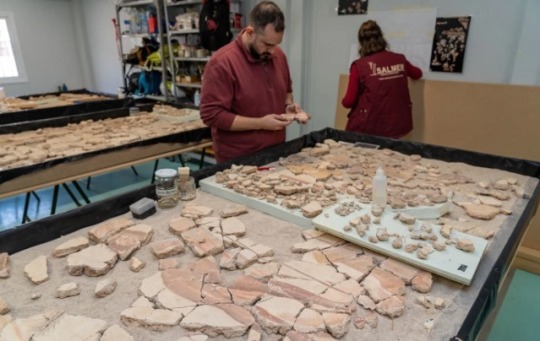

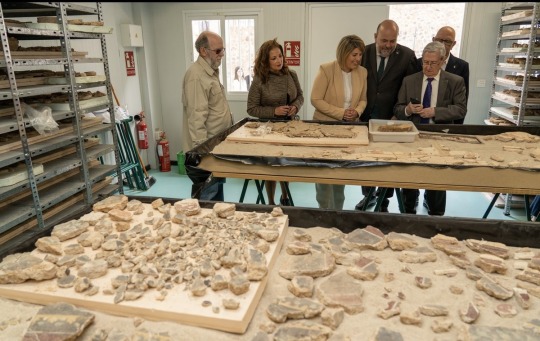
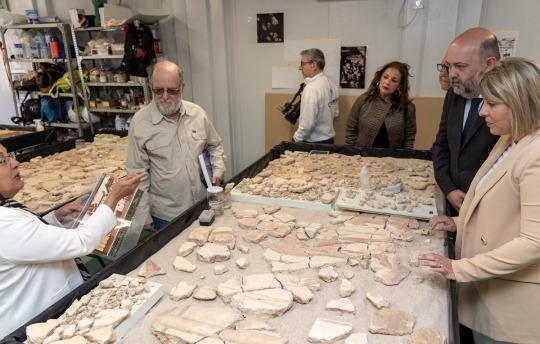
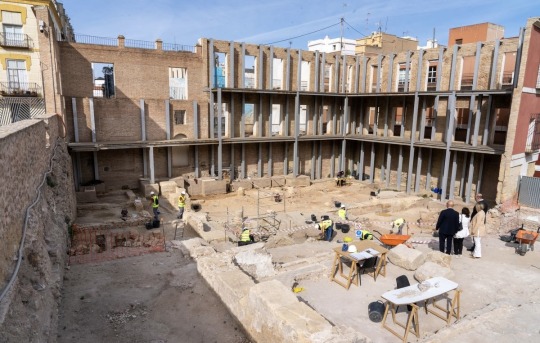
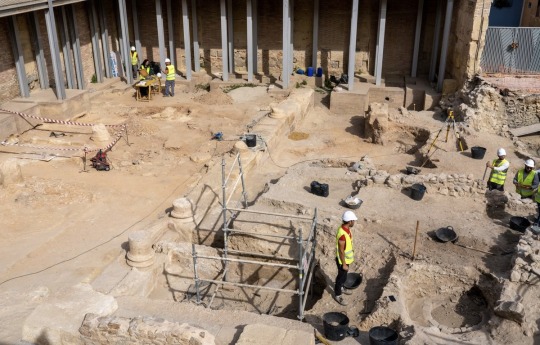

Fragments From a Wall Mural Discovered at a Roman Theater in Spain
ARCHAEOLOGISTS HAVE DISCOVERED FRAGMENTS FROM A WALL PAINTING THAT DECORATED A PORTICO IN CARTAGENA’S ROMAN THEATRE.
Cartagena was founded as a Carthaginian city in 228 BC in south-eastern Iberia, Spain. The city was called Qart Hadasht, meaning “new city”, and served as a staging point for Carthaginian incursions into Spain.
The Roman general, Scipio Africanus, conquered the city in 209 BC, and renamed it as Carthago Nova, emerging as the capital of the Roman province of Carthaginensis.
Between 5 and 1 BC, the Romans constructed a large, monumental theatre, which had a cavea that could hold up to 7,000 spectators for public performances and ceremonies.
The theatre was discovered in 1988 during the construction of the Centro regional de artesanía, resulting in a long-term project of restoration and reconstruction, turning the theatre into an open-air museum.
Recent excavations by a team of archaeologists have discovered over 2,000 fragments from a large mural painting. The painting decorated the walls of a portico (porticus post scaenam) with a double porticoed gallery, revolving around a central room housing a garden at the back of the stage in the western section of the theatre complex.
The discovery adds to 1,500 fragments previously uncovered in 2006, allowing the researchers to continue the process of restoring the painting to its original design with more accuracy.
Although restoration is still in its early stages, depictions of ornate Roman figures are beginning to emerge, in addition to linear artistic features.
Excavations are planned to explore the central garden, where the researchers hope to find evidence of flower beds, piping that fed water to fountains, as well as understand how water was used to maintain the flora in the open space.
#Fragments From a Wall Mural Discovered at a Roman Theater in Spain#Cartagena#Scipio Africanus#ancient artifacts#archeology#archeolgst#history#history news#ancient history#ancient culture#ancient civilizations#roman history#roman empire#roman art
60 notes
·
View notes
Photo
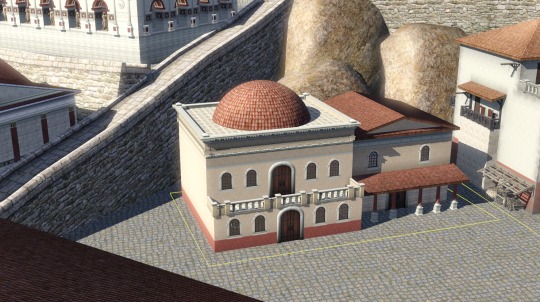





A City of Brick, a City of Marble (2023)
A few screenshots of a personal project I made in the Sims 3. Called Latium, it an artistic and significantly scaled down reproduction of Ancient Rome during the First Century CE. Featured are various artistic depictions of real-world structures that have been constructed in the Roman Forum and the foot of the Capitoline Hill as they might’ve appeared toward the end of Emperor Augustus’ rule.
Other buildings are reconstructions of commoner structures that would’ve filled in the space between the monuments of the real city. I drew inspiration from various reconstructions of the era (both historical and artistic), most notably Digitalis Forum Romanum and the sets of HBO’s Rome and the BBC’s Ancient Rome: Rise and Fall of an Empire.
Progress report:
I finally built the shell of the Mamertine Prison. I moved and embellished two of the insulae and moved them to the foot of the Capitoline hill. Also, I built a smaller version of the Porticus Deorum Consentium.
This basically begins the first of the actual street scenes leading into the city center and creates a very big contrast between the Augustan Forum in its splendor and the blighted lives of the Empire’s working classes. My next task is to sculpt and landscape the Capitoline hill then work my way outward to the other geographic features.
You can view the rest of this project on my dedicated Sims 3 build blog.
–
Program: The Sims 3, The Sims 3 Create-A-World
Date: 27 January 2023
Usage: In progress
103 notes
·
View notes
Photo
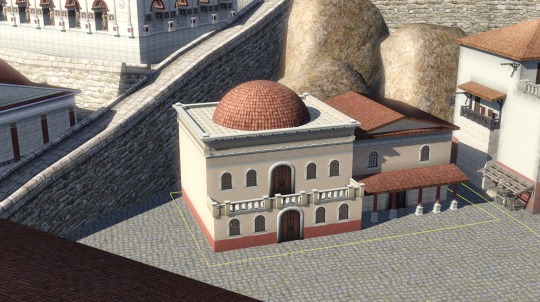
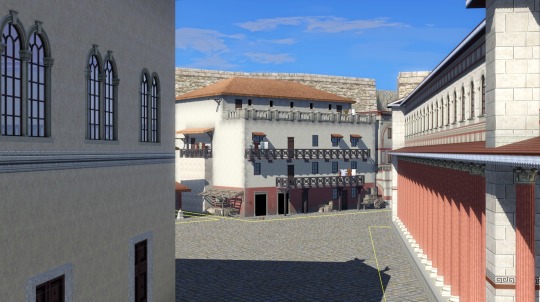
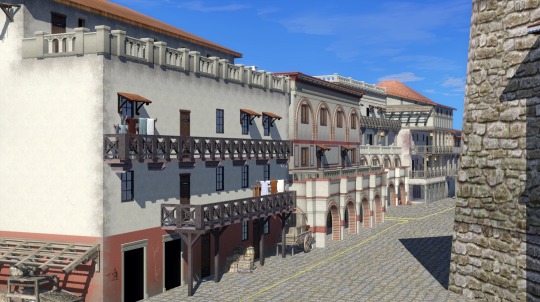

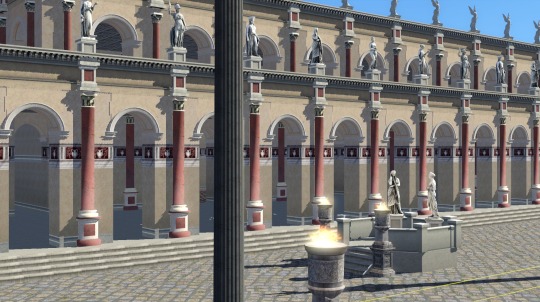

A city of brick, a city of marble.
I finally built the shell of the Mamertine Prison. I moved and embellished two of the insulae and moved them to the foot of the Capitoline hill. Also, I built a smaller version of the Porticus Deorum Consentium.
This basically begins the first of the actual street scenes leading into the city center and creates a very big contrast between the Augustan Forum in its splendor and the blighted lives of the Empire’s working classes. My next task is to sculpt and landscape the Capitoline hill then work my way outward to the other geographic features.
Cross-posted from my art blog.
75 notes
·
View notes
Text

Porticus I
#black and white#photography#art#analog#film photography#film#35mm film#35mm#35mm black and white#b&w photography#bremen
4 notes
·
View notes
Text
"In De Haruspicum Responso (49) Cicero tells us that Clodius announced in public assembly that he wished to build on the Carinae on the Mons Oppius a second porticus quae Palatio responderet. In context he clearly means that Clodius hoped to drive Pompey into exile as he had Cicero, to destroy Pompey's Domus Rostrata, and to use the land for the construction of a porticus, perhaps in conjunction with the Temple of Tellus that was located nearby, that would match the Porticus Catuli as he had rebuilt it."
- Steven M. Cerutti, The Location of the Houses of Cicero and Clodius and the Porticus Catuli on the Palatine Hill in Rome
Hello.
4 notes
·
View notes
Text
Forest Tenure Funders Group
Recognizing a critical need to increase support for Indigenous Peoples and Local Communities (IPLC), a historic announcement was made at COP26 by 22 bilateral and philanthropic donors pledging $1.7 billion between 2021-2025 to advance forest tenure rights in tropical forest countries.
The IPLC Forest Tenure Pledge is a commitment to mobilize greater and more effective donor support for forest communities. The Funders Group is committed to ongoing dialogue with both IPLC leaders and wider stakeholders to facilitate exchanges of information, feedback on Pledge progress, and increase opportunities for collaboration.
Who are the pledge donors?
A. GOVERMENTS
(1) United States of America - the United States Agency for International Development (USAID)
(2) United Kingdom of Great Britain and Northern Ireland
(3) Kingdom of Norway
(4) Federal Republic of Germany - Ministry for Economic Cooperation and Development (BMZ)
(5) Kingdom of the Netherlands
B. PRIVATE DONORS
(1) Ford Foundation
(2) The Christensen Fund
(3) The David and Lucile Packard Foundation
(4) Children's Investment Fund Foundation CIFF
(5) Sobrato Philantropies
(6) Good Energies Foundation by Porticus
(7) Oak Foundation
(8) The William and Flora Hewlett Foundation
(9) Wellspring Philantropic Fund
C. PROTECTING OUR PLANET CHALLENGE
(10) Arcadia
(11) The Bezos Earth Fund
(12) Bloomberg Philanthropies
(13) The Bobolink Foundation
(14) Gordon and Betty Moore Foundation
(15) International Conservation Fund of Canada
(16) Nia Tero
(17) Rainforest Trust
(18) Re:wild
(19) Wyss Foundation
(20) Rob and Melani Walton Foundation
2 notes
·
View notes
